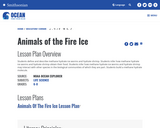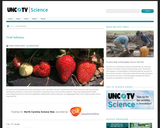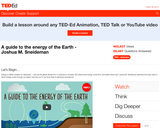
This parent guide supports parents in helping their child at home with the 8th grade Science content.
- Subject:
- Science
- Material Type:
- Reference Material
- Vocabulary
- Author:
- Kelly Rawlston
- Letoria Lewis
- Date Added:
- 10/11/2022

This parent guide supports parents in helping their child at home with the 8th grade Science content.

This resource accompanies our Rethink 8th Grade Science course. It includes ideas for use, ways to support exceptional children, ways to extend learning, digital resources and tools, tips for supporting English Language Learners and students with visual and hearing impairments. There are also ideas for offline learning.

Students learn about methane hydrate ice worms and hydrate shrimp, including how they obtain their food and interact with other species in deep sea ecosystems. Students will work in collaborative groups to research these organisms to develop hypotheses about the relationship between methane hydrates, ice worms, and hydrate shrimp and present their hypotheses to the class. In an extension activity, students will construct models of methane hydrate molecules.

This resource is an article discussing the processes of photysynthesis and respiration.

In this activity, students will measure the rate at which the photosynthesis process occurs. Students will work in small groups to design an experiment with one independent variable and test this variable on spinach leaf disks.

This teaching guide provides background information and extension questions to accompany several Twig videos that deal with plants' energy and growth needs.

Students will test whether iron is present in cereal.

This multimedia resource, part of the NC Science Now series, describes how a North Carolina State University scientist is extracting and concentrating healthy ingredients from fruits and vegetables and infusing them into a protein flour that could be used in powerbars, smoothies, or other foods. Components of this resource include a video, related text articles, a photo gallery, and an interview with a food scientist. Links to these components are provided on the page under the heading "UNC-TV Media."

This brief video lesson edxamines the many ways in which energy cycles through our planet, from the sun to our food chain to electricity and beyond. Discussion/assessment questions and suggested supplemental resources are also included.

Students take samples of a range of foodstuffs and burn them under a boiling tube containing a measured amount of water. They will measure the temperature increase in the water and calculate the amount of energy needed to cause that temperature increase, indicating the amount of energy stored in the food.

Students explore interactives to learn about hydrothermal vent chemistry and the animals that have adapted to living in the harsh environment near vents.

This lesson focuses on energy production in the body through the digestion of food. The concepts covered here involve the expenditure of energy from nutrition and cellular respiration, with a particular focus on the strenuous energy demands of marathon running. For the learning activities, students will design their own menu to prepare for the big race, with careful attention to prevent hitting the wall's situation caused by depletion of a glycogen source in the body during extreme activity.

Students will learn about deep-sea tubeworms. Students will work collaboratively to create a poster or three-dimensional model of a tubeworm. Each group will then prepare a written report describing the anatomy of tubeworms, how a tubeworm obtains food and the symbiotic relationship between the tubeworm and chemosynthetic bacteria, and the role that tubeworms play in the larger cold-seep food web.

In this series of activities, students will design and build models of nine life support systems which are crucial to a successful settlement of the Moon. They will make plans based on their knowledge of how these systems work on Earth.

Students will be able to describe major features of cold seep communities; list at least five organisms typical of these communities; infer probable trophic relationships among organisms typical of cold-seep communities and the surrounding deep-sea environment; describe the process of chemosynthesis in general terms; contrast chemosynthesis and photosynthesis; and describe at least five deep-sea predator organisms. Students will work in collaborative groups to research the ecology of cold seep communities and orally present their findings to the rest of the class. The teacher will also lead an effort to create a food web showing the ecological relationships of these communities.

Part of The Science Inside series, this easy-to-read booklet discusses the importance of good health habits such as eating right and exercising. 77 pages

This series of lessons focuses on food production in ocean ecosystems. In Lesson Plan 15, "Being Productive in the Arctic Ocean," students will investigate how organisms make food, either through photosynthesis or chemosynthesis. They will also identify factors that limit primary productivity and explain their effects. In Lesson Plan 16, "Chemosynthesis for the Classroom," students will observe the development of chemosynthetic bacterial communities in black mud and explain the relevance of chemosynthesis to biological cold-seep communities. In Lesson Plan 17, "Biochemical Detectives,' students will explore the energy-obtaining strategies of cold-seep organisms and study actual data from biochemical studies involving these organisms. Students will write brief essays summarizing each lesson as assessment.

This course was created by the Rethink Education Content Development Team. This course is aligned to the NC Standards for 8th Grade Science.

This course was created by the Rethink Education Content Development Team. This course is aligned to the NC Standards for 8th Grade Science.

This course was created by the Rethink Education Content Development Team. This course is aligned to the NC Standards for 8th Grade Science.